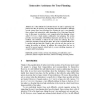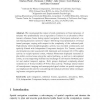SPATIALCOGNITION
2010
Springer
13 years 2 months ago
2010
Springer
How are space and time represented in the human mind? Here we evaluate two theoretical proposals, one suggesting a symmetric relationship between space and time (ATOM theory) and t...
SPATIALCOGNITION
2010
Springer
13 years 2 months ago
2010
Springer
It is often difficult for individual tourists to make a sightseeing tour plan because they do not have prior knowledge about the destination. Although several systems have been dev...
SPATIALCOGNITION
2010
Springer
13 years 2 months ago
2010
Springer
Survey knowledge of spatial environments can be successfully conveyed by visual maps. For visually impaired people, tactile maps have been proposed as a substitute. The latter are ...
SPATIALCOGNITION
2010
Springer
13 years 2 months ago
2010
Springer
We investigated the impact of path complexity on brain dynamics of subjects who preferentially use an egocentric (Turners) or an allocentric (Nonturners) reference frame during spa...
SPATIALCOGNITION
2010
Springer
13 years 2 months ago
2010
Springer
Abstract. Across cultures, people conceptualize time as if it flows along a horizontal timeline, but the direction of this implicit timeline is culture-specific: in cultures with l...


